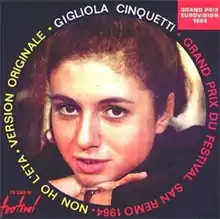| "Non ho l'età" | ||||
|---|---|---|---|---|
 | ||||
| Single by Gigliola Cinquetti | ||||
| B-side | "Sei un bravo ragazzo" | |||
| Released | 28 January 1964 | |||
| Genre | Ballad | |||
| Length | 3:10 | |||
| Label | CGD Records | |||
| Songwriter(s) |
| |||
| Producer(s) | Mario Panzeri | |||
| Gigliola Cinquetti singles chronology | ||||
| ||||
| Eurovision Song Contest 1964 entry | ||||
| Country | ||||
| Artist(s) | ||||
| Language | ||||
| Composer(s) | ||||
| Lyricist(s) | ||||
| Conductor | Gianfranco Monaldi | |||
| Finals performance | ||||
| Final result | 1st | |||
| Final points | 49 | |||
| Entry chronology | ||||
| ◄ "Uno per tutte" (1963) | ||||
| "Se piangi, se ridi" (1965) ► | ||||
"Non ho l'età (per amarti)" (Italian for "I'm not old enough (to love you)"), usually given as just "Non ho l'età" (pronounced [non ˈɔ lleˈta]), was the winning song in the Eurovision Song Contest 1964, held in Copenhagen. It was performed in Italian by Gigliola Cinquetti representing Italy. Like all previous Italian Eurovision entries, the song had also won that year's Sanremo Music Festival. Cinquetti was sixteen years old, making her the youngest Eurovision winner in history until 1986 when Belgium's Sandra Kim won the contest with "J'aime la vie" – initially claiming to be fifteen, it was later revealed that Kim was only thirteen.[1] In 1990, the EBU made a new rule requiring contestants to be aged 16 or older before the contest; this age rule still operates.
The song was performed twelfth on the night, following Portugal's António Calvário with "Oração" and preceding Yugoslavia's Sabahudin Kurt with "Život je sklopio krug". By the close of voting, it had received 49 points, placing it first in a field of 16.
"Non ho l'età" became a considerable commercial success for Cinquetti, in Italy, the rest of Europe, Scandinavia and other countries worldwide; she also recorded the song in English ("This is my prayer"), Spanish ("No tengo edad"), French ("Je suis à toi"), German ("Luna nel blu"), and Japanese ("Yumemiru omoi", 夢みる想い). The song has since been recorded by a wide range of artists in other languages, for example, in Icelandic as "Heyr mína bæn" by Ellý Vilhjálms.[2][3] Lili Ivanova, a famous Bulgarian singer, and Hong Kong singer Rebecca Pan, covered the song in 1964. Polish-Belarusian singer Wiesława Drojecka covered the song in Polish ("Nie wolno mi"). Anneli Sari made a Finnish cover ("Liian nuori rakkauteen"). Sandra Reemer recorded the song in Dutch ("Als jij maar wacht").
The song was followed as contest winner in 1965 by France Gall singing "Poupée de cire, poupée de son" for Luxembourg. It was followed as Italian representative that year by Bobby Solo with "Se piangi, se ridi".
Cinquetti later returned to perform at the contest in 1974, when she finished second with "Sì", behind ABBA's "Waterloo". In 1991, she co-hosted the contest in Rome alongside Toto Cutugno. In 2022, she performed the song as an interval act at the Eurovision final in Turin.
Cinquetti was proved not to be a UK 'one-hit-wonder' when an English recording of her 1974 Eurovision entry (titled "Go") reached #8 in the UK chart.
Charts
| Chart (1964–65) | Peak position |
|---|---|
| Argentina (CAPIF)[4] | 5 |
| Belgium (Ultratop 50 Flanders)[5] | 1 |
| Belgium (Ultratop 50 Wallonia)[6] | 1 |
| Finland[4] | 5 |
| France (InfoDisc)[7] | 1 |
| Germany (Media Control AG)[8] | 3 |
| Hong Kong[4] | 2 |
| Italy (Musica e dischi)[9] | 1 |
| Netherlands (Single Top 100)[10] | 2 |
| Norway (VG-lista)[11] | 3 |
| UK Singles (OCC)[12] | 17 |
Linda Scott's version
| "This Is My Prayer" | |
|---|---|
| Single by Linda Scott | |
| from the album Hey, Look at Me Now! | |
| A-side | "That Old Feeling" |
| Released | 1964 |
| Length | 2:54 |
| Label | Kapp Records |
| Songwriter(s) | Kaye-Springer-Nisa |
| Producer(s) | Mike Berniker |
Linda Scott's recording of the song's English version, "This Is My Prayer", was released as the B-side of the single "That Old Feeling" in late 1964. In the Philippines, it topped the national chart for 12 straight weeks beginning on 12 December 1964.[13][14]
References
- ↑ O'Connor, John Kennedy. The Eurovision Song Contest - The Official History. Carlton Books, UK. 2007 ISBN 978-1-84442-994-3
- ↑ Thorsson, Leif. Melodifestivalen Genom Tiderna. Premium Publishing, Sweden. 1999 ISBN 91-89136-00-4
- ↑ Rateyourmusic.com, Gigliola Cinquetti, discography entry
- 1 2 3 "Hits of the world - Argentina" (PDF). Billboard. 29 August 1964. p. 26. Retrieved 9 June 2023.
- ↑ "Gigliola Cinquetti – Non ho l'età" (in Dutch). Ultratop 50.
- ↑ "Gigliola Cinquetti – Non ho l'età" (in French). Ultratop 50. Retrieved 25 February 2017.
- ↑ "Tout les Titres par Artiste - C" (in French). Infodisc.fr. Archived from the original on 17 February 2014. Retrieved 10 June 2012. Select Gigliola CINQUETTI from the menu, then press OK.
- ↑ "Single - Gigliola Cinquetti, Non ho l'età" (in German). Charts.de. Media Control. Retrieved 10 June 2012.
- ↑ https://en.wikipedia.org/wiki/List_of_number-one_hits_of_1964_(Italy).
{{cite web}}: Missing or empty|title=(help) - ↑ "Gigliola Cinquetti – Non ho l'età" (in Dutch). Single Top 100.
- ↑ "Gigliola Cinquetti – Non ho l'età". VG-lista.
- ↑ "Gigliola Cinquetti: Artist Chart History". Official Charts Company.
- ↑ "Philippines". Billboard. The Billboard Publishing Company. 12 December 1964. p. 19. Retrieved 29 October 2020.
- ↑ "Philippines". Billboard. The Billboard Publishing Company. 27 February 1965. p. 22. Retrieved 29 October 2020.